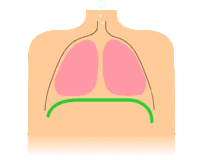Diaphragmatic breathing
Diaphragmatic breathing, or deep breathing, is breathing that is done by contracting the diaphragm, a muscle located horizontally between the thoracic cavity and abdominal cavity. Air enters the lungs, the chest does not rise and the belly expands during this type of breathing. Diaphragmatic breathing is also known scientifically as eupnea, which is a natural and relaxed form of breathing in all mammals. Eupnea occurs in mammals whenever they are in a state of relaxation, i.e. when there is no clear and present danger in their environment.

Explanation
According to the National Center for Complementary and Integrative Health, "12.7 percent of American adults [have] used deep-breathing exercises... for health purposes,"[1] which it describes as follows, "Deep breathing involves slow and deep inhalation through the nose, usually to a count of 10, followed by slow and complete exhalation for a similar count. The process may be repeated 5 to 10 times, several times a day."[2]
According to the University of Texas Counseling and Mental Health Center, "Diaphragmatic breathing allows one to take normal breaths while maximizing the amount of oxygen that goes into the bloodstream. It is a way of interrupting the 'Fight or Flight' response and triggering the body's normal relaxation response." [3] They provide a video demonstration.[4]
In complementary and alternative medicine
Some practitioners of complementary and alternative medicine believe that particular kinds of breathing they identify as diaphragm breathing can be used to bring about health benefits.[5]
Deep breathing exercises are sometimes used as a form of relaxation, that, when practiced regularly, may lead to the relief or prevention of symptoms commonly associated with stress, which may include high blood pressure, headaches, stomach conditions, depression, anxiety, and others.[6]
Due to the lung expansion being lower (inferior) on the body as opposed to higher up (superior), it is referred to as 'deep' and the higher lung expansion of rib cage breathing is referred to as 'shallow'. The actual volume of air taken into the lungs with either means varies.
Relation to yoga and meditation
Hatha Yoga, tai chi and meditation traditions draw a clear distinction between diaphragmatic breathing and abdominal breathing or belly breathing.[7] The more specific technique of diaphragmatic breathing is said to be more beneficial.[7]
Benefits
The use of diaphragmatic breathing is commonly practiced, especially in those patients with chronic obstructive pulmonary disease, to improve a variety of factors such as pulmonary function,[8] cardiorespiratory fitness,[8] respiratory muscle length,[9] and respiratory muscle strength.[10] Specifically, diaphragmatic breathing exercise is essential to asthmatics since breathing in these patients is of the thoracic type in association with decreased chest expansion and chest deformity as a result of a deformed sternum like pectus excavatum (funnel chest); a shortened diaphragm, intercostals and accessory muscles from prolonged spasm causing stenosis of the major airways leading to an abnormal respiratory pattern.[11]
Relation to music
Diaphragmatic breathing is also widely considered essential for best possible singing performance.[12] Diaphragmatic breathing also allows wind instrumentalists to maximise intake of air, minimising the number of breaths required for progressing players.
See also
- Breath
- Buteyko method
- Circular breathing
- Kussmaul breathing
- Pranayama – a traditional Yogic practice of slowing and extending the breaths, used during meditation
- Shallow breathing – a type of breathing that is mutually exclusive to diaphragmatic breathing and is associated with multiple anxiety disorders
- Wim Hof method
Notes
- "Relaxation Techniques for Health: An Introduction" http://nccih.nih.gov/health/stress/relaxation.htm
- http://nccih.nih.gov/health/providers/camterms.htm "Terms Related to Complementary and Alternative Medicine"
- "Stress Management and Reduction at the University of Texas at Austin".
- "diaphragmatic breathing video".
- Shaw, B.S.; Shaw, I. (2013). "Review of the effectiveness of various modes of breathing training in asthma management". African Journal for Physical, Health Education, Recreation and Dance. November (Supplement 1): 168–179. Retrieved 2015-02-11.
- "To relax using this method, you consciously slow your breathing and focus on taking regular and deep breaths...Because relaxation is the opposite of stress, the theory is that voluntarily creating the relaxation response through regular use of relaxation techniques could counteract the negative effects of stress...Chronic stress may lead to high blood pressure, headaches, stomach ache, and other symptoms. Stress may and in many cases will worsen certain conditions, such as asthma. Stress also has been linked to depression, anxiety, and other mental illnesses." - Relaxation Techniques for Health: An Introduction
- "Breathing Practices and Pranayama". Retrieved January 29, 2014.
- Shaw, I.; Shaw, B.S.; Brown, G.A. (2010). "Role of Diaphragmatic Breathing and Aerobic Exercise in Improving Maximal Oxygen Consumption in Asthmatics". Science & Sports. 25 (3): 139–145. doi:10.1016/j.scispo.2009.10.003.
- Shaw, B.S.; Shaw, I.; Brown, G.A. (2013). "Concurrent aerobic and resistive breathing training improves respiratory muscle length and spirometry in asthmatics". African Journal for Physical, Health Education, Recreation and Dance. November (Supplement): 180–193. Retrieved 2015-02-11.
- Shaw, I.; Shaw, B.S. (2014). "The effect of breathing and aerobic training on manual volitional respiratory muscle strength and function in moderate, persistent asthmatics". African Journal for Physical, Health Education, Recreation and Dance. Supplement 2 (September): 45–61. Retrieved 2015-02-11.
- Shaw, B.S.; Shaw, I. (2011). "Pulmonary function and abdominal and thoracic kinematic changes following aerobic and inspiratory resistive diaphragmatic breathing training in asthmatics". Lung. 189 (2): 104–106. doi:10.1007/s00408-011-9281-8. PMID 21318637.
- "Confused About Diaphragmatic Breathing?".
References
- "Better Breathing". Learning to sing - Breathing.